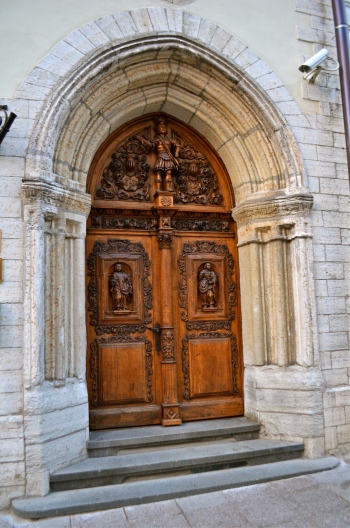Learning about Tallinn’s history I heard a phrase I haven’t heard since my high school Western Civilizations class, The Hanseatic League. Huh? What does that have to do with anything? Learning about it was pretty cool. The Hanseatic League was middlemen/traders. For about 500 years (from 1250-1750), they controlled most of the commerce in northern Europe.
Before the rise of powerful kings and the modern nation-state, local leaders ruled small fiefdoms, kingdoms, dukedoms and probably other –doms. Local governments were small and relatively weak. City dwellers were interested in trade, but paying taxes and tolls to each and every feudal overlord was excessive and impeded trade. Rulers and the various -doms were too small to develop an effective coordinated response to pirates on the seas. It was difficult to conduct any sort of large-scale commercial activity in such an environment.
Enter the Hanseatic League. Prominent merchants banded together, forming a merchant guild to defend themselves against pirates. They hired armies to protect their ships and ports. It worked well and they began establishing trading posts in abroad where they bargained with local leaders for discounts. The Hanse (which in German means trading guild) would trade fish from Scandinavia for grain from the Baltics or luxury goods from Flanders or English wool. It worked well and trade flourished. Everyone got something out of it and the League got rich off of their cut. Not only rich, in a time before strong nation states, they became powerful. In their heyday, they were a dominant force and stabilizing influence.
If it worked, what happened? Rising nation states, particularly their kings, didn’t want to compete for power and were jealous of the League’s wealth. Plus, the post-reformation religious wars tore apart old Hanseatic alliances. By the 16th century, trade moved decisively to the south and west as countries like Portugal, Italy, Spain and France set ships to explore and return with treasures from Africa and the Americas.
We took the ferry from Helsinki to Tallinn, Estonia. While it was a short ride, it had a culture that was distinct from Scandinavia, both Nordic and Russian. After the decline of the Hanseatic League, it experienced two centuries of Tsarist Russia rule before World War I and 45 years of communist rule after World War II. In September 1991, Estonia left the Soviet Union and declared independence (along with the three Baltic states of Latvia, and Lithuania). The U.S.S.R. recognized Estonia as being independent on September 6, 1991. In November Yeltsin issued a decree banning the Communist Party throughout Russia.
While independence was natural for many Estonians, it has an enormous Russian population, many of whose families came during communism and never fully integrated. Nevertheless, many Estonians think of themselves as part of the Nordic and European sphere and Estonia is part of the European Union.
It was a quick walk into the old town Tallinn from the ferry terminal and an easy cab ride to the airport. While we saw old wood buildings in the areas surrounding the old town, the walled city has an Old World ambience. Tallinn’s old town medieval center is amazingly well-preserved as there wasn’t a lot of building there during communism. The old town has watchtowers, colorfully painted medieval houses, cobblestoned lanes, and old Lutheran churches.
Post-communism, Tallinn modernized quickly and prices have risen with the development. Even so, being used to Swiss prices, we almost cheered when we saw Tallinn’s rates. The food was great and we enjoyed dinners out, something we don’t do often in Geneva. We weren’t the only ones, the streets were filled with people eating, drinking and making merry. There was a general relaxed, happy summer vibe. Scandinavians, especially Swedes and Finns, come for a night away and cheap alcohol as it is very highly taxed in their home countries.


The Town hall of Tallinn, Estonia. Eesti: Tallinna raekoda. Français : L’hôtel de ville de Tallinn, en Estonie. Русский: Таллинская Ратуша. (Photo credit: Wikipedia)
Town Hall Square has served as a marketplace since the time of the Hanseatic League. The 15th century Town Hall dominates the square. There are lots of impressive churches like the Cathedral of Saint Mary o, but the best part about Tallinn is the Estonians who inhabit it and how well-preserved it is. Enjoy wandering the streets, talking to people and taking in all the details.












 In the
In the 








